April 7th of 1939, Italy invades Albania and by April 12th, Albania capitulated, King Zog fled for Greece and the Albanian Parliament had offered the crown to Italian King Victor Emmanuel III. This created an environment that led to the rise of many Albanian “Resistance” organizations. First against the Italians, then the Germans, and finally against the communists.
In the 1940’s a set of 4 stamps featuring scenes of Albanian Resistance Fighters first appeared. And towards the end of the 1940’s a 2nd, 3rd and 4th series appeared. An updated set in 1952 and finally overprinted stamps in the 1960’s.
With all likelihood, most, if not all, of these stamps were purely philatelic bogus sets issued to sell to collectors, however, there is a slight chance that at least the first set was actual propaganda for one of the resistance groups, but this is doubtful.
Resistance Groups
The first resistance groups formed during the Italian occupation of Albania from 1939 – 1943. In November or December of 1941, Kostandin Cekrezi, who had fled Albania and eventually ended up in Boston, formed the committee “Free Albania” (Albanien: Shqipëria e Lirë) and began publishing a newsletter from the United States.
Around the same time, in Albania, communist groups formed the Albanian Communist Party in Tirana. The Albanian Communists fought against the Italians and later the occupying Germans until they drove the Germans out and took control of the country in November of 1944.
In 1942, a western orientated anti-communist, anti-monarchy group called “Balli Kombetar” (National Front) was formed. This group spent as much time fighting the communists as they did fighting the Italians and the Germans. After the war most of the members (Ballists) either fled the country, were imprisoned or were executed.
Beginning in 1947, covert operations by the British SIS and the American CIA were begun in order to subvert the communist regime in Albania (Operation BGFIEND). The paramilitary operations began in 1947, resulted in the forming of the “Free Albania Committee ” – or – “National Committee for a Free Albania (NCFA)” – (a political front for the secret operation) in 1949 and ran at least through 1952 based on recently declassified US Government documents. Much of this operation involved training existing Albanian anti-communists, Ballists, and Zog Supporters and the supply of resistance fighters through parachute drops. The operation also, according to the CIA documents, dropped Leaflets with anti-communist propaganda. and on at least one occasion, mentions the dropping of “stamp sized leaflets” (see footnote). Overall however, the operation was a failure.
The Stamps
4 distinct series of stamps inscribed “Shqipnija” and featuring the phrase “Komitetit Te Qindreses” are currently known to exists. All 4 series are denominated as semi-postals and all but the first set feature the Albanian Air Post phrase: “Posta Ajrore”.
Shqipnija
This term which is a spelling of Albania only appears on officially released stamps on the 1944 Semi Postal “Aid to Bombing Victims” set released under German Occupation.
The spelling appears to be of the Albanian Gheg Dialect. Gheg is spoken in Northern Albania, Kosovo, northwestern Republic of Macedonia, southern Montenegro and Serbia. It is also spoken in parts of Sicily and southern Italy.
The spelling appears on a map created in 1941 by Professor Ahmet Gashi. The map was titled “Shqipnija E Vertete” which translates to “Albania True” and describes a greater Albania encompassing additional surrounding territories in other countries. Gashi was born in Pristina Kosovo (Yugoslavia), studied in Turkey and at the time the map was created, lived in Tirana.
Other printed works use the term Shqipnija. The work: “Shqipnija: Para Dy Shekujsh” by Kosovian born Salih Vuceterni, and other works.
The spelling also appears in the text of leaflets dropped in Albania by operation BGFIEND. The leaflets are attributed to the National Committee for a Free Albania and contain the phrase: “Komiteti Kombetar “Shqipnija e Lire” “ The phrase was only used on the first 3 leaflets air-dropped in 1950, the phrase was changed later as the remaining leaflets dropped use the phrase: “Komiteti ‘ Kombetar “Shqiperia e Lire”” (Shqiperia instead of Shqipnija).
Komitetit Te Qindreses
This phrase seems to translate to “of the Resistance Committee”. The word “Qindreses” doesn’t translate well, but is the Gheg spelling spelling of “qendreses” which means “Resistance”. There are many dialects of Albanian spoken in Greece and parts of southern Italy. There are at least 2 works that use the term, and both were written by Albanians from either Northern Albania or Montenegro The full phrase “Posta E Komitetit Te Qindreses” translates to “Postage of the Resistance Committee”. Of note is that later sets drop the “Posta E”.
Series 1: Albanian Resistance Fighters
The first series of stamps is a set of 4 featuring images of resistance fighters and symbols of resistance.
This is most likely the first set of stamps that were produced, and were probably created anywhere between the years of 1940 and 1944 although it is most likely that they were produced after the end of WWII and are probably anti-communist in nature. Based on the denominations used, the probable guess would be 1944 as we have an example on cover dated September 19th, 1944.
| Details, designs A1-A4, 1945? | ||||||||||||||||||||
Printing Method: LithographedPerforation: 11.25 x 11.25Size: 39.5mm x 29mm
|
The denominations are written as “Fr. Shq.” – This terminology first appeared on official Albanian stamps in April of 1943 on the semi-postal “Fighting Tuberculosis” set. These official stamps were printed under Italian Occupation. The top value of the set was a 100Q+40Q stamp written as “1Fr Shq.” Prior to 1943, values above 100Q were written as “Fr Af.” The last set of stamps to feature “Fr Shq.” were overprints issued in 1945 while still under German occupation. Subsequent to this, stamps dropped the “q” and were written as “Fr. Sh.”
The “Franga” (Fr) was used in Albania from 1926 until 1946. It represented 5 Lek. It was first introduced by King Zog and appeared on coins up until 1939. It is possible that the “Fr Shq” currency was used on these stamps as a homage to Zog and his supporters. The values are extremely high however. The top value stamp officially issued in this timeframe was a 5fr in 1945 (overprint). The top value in this resistance series was 10Fr+7 which, with the surcharge, was nearly 3 times the top value of any official stamp released.
In 1947, the Franga was dropped in officially released stamps and all future stamps used Lek for the high values.
The design of these stamps does appear to be Anti-Communist in nature. The motif of a “Free Traditional Highlander” is Northern Albanian in nature. The woman in the first stamp appears to be Catholic. According to Bardh, they don’t appear to be from the National Front, or any royalist group and if they are propaganda, they would have originated with a Northern Albanian group.
The second series of stamps feature 3 designs and one design overprinted.
These were likely printed in the late 40’s, and based on a few covers that exist bearing these stamps, the probable year was 1947. This series (and all remaining series) feature the phrase “POSTA AJRORE” which identifies these as Airpost stamps. The artwork on this set is much more crude than in set 1.
| Details, designs A5-A7, 1947? | |||||||||||||||||||||||||||||||||||
Printing Method: Lithographed Perforation: 11 x 11.25 (horiz), 11.25 x 11 (vert)Size: 35mm x 23.5mm (horiz), 24mm x 35mm (vert)
|
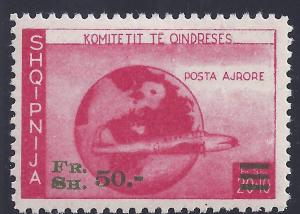 There is 1 overprinted stamp in this series, 50Fr Sh surcharged on the red 20+10 Fr Shq. (Note: the overprint seems to drop the “Shq” in favor of “Sh”
There is 1 overprinted stamp in this series, 50Fr Sh surcharged on the red 20+10 Fr Shq. (Note: the overprint seems to drop the “Shq” in favor of “Sh”
The airplane featured on the 20+10 Fr Shq stamp appears to look like a Boeing 247. This plane probably wasn’t used by the Americans or British for air-drops as all references seem to indicate the use of the Douglas DC-3 (C-43).
It is nearly certain that these stamps were not printed by the same group that printed series 1.
Series 3: Figures of Freedom
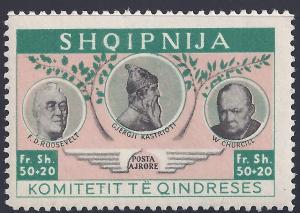 Series 3 contains just 1 stamp, and this stamp could have possibly been printed at the same time as Series 2 even though it is of different size and appearance. This stamp features 3 vignettes of world figures representing freedom and is definitely anti-communist in nature.
Series 3 contains just 1 stamp, and this stamp could have possibly been printed at the same time as Series 2 even though it is of different size and appearance. This stamp features 3 vignettes of world figures representing freedom and is definitely anti-communist in nature.
The center figure is Gjergji Kastrioti (Skanderberg) who was a 15th century Christian leader who fought against the Ottomon’s in Albania. He is considered a national hero and was a key figure of the Albanian National Awakening and Independence in the early part of the 20th century.
The stamp also depicts Franklin Delano Roosevelt and Winston Churchill.
Of note is the misspelling of “Churchill” as “Churcill”.
| Details, design A8, 1947? | |||||||||||||||
Printing Method: LithographedPerforation: 11 x 11Size: 44.5mm x 28.5mm on (A) white or (B) brown paper
|
Series 4: Figures of Freedom (Re-drawn)
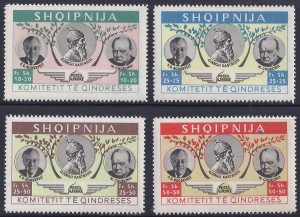 This series of stamps, most likely printed in the United States and sold to collectors, is modeled after the stamp from Series 3 featuring Kastrioti, FDR and Churchill.
This series of stamps, most likely printed in the United States and sold to collectors, is modeled after the stamp from Series 3 featuring Kastrioti, FDR and Churchill.
This series contains 4 values and 4 color varieties. In addition these are known imperf and in 2 perforation sizes.
These stamps began to flood the philatelic market in the United States in the early 1950’s.
| Details, designs A9-A12, 1950? | ||||||||||||||||||||||||||||||||||||||||||||||||||||||||||||||||||||||||||||||||
Printing Method: Photogravure, sheets of 50Perforation: (A) 12.5 x 12.5, (B) 14 x 14, (C) ImperfSize: 44.5mm x 28.5mm
|
The printing of these stamps is Photogravure (versus Lithography) and there are some design differences including different portraits for FDR and Kastrioti, heavier shading on the branches, and on the symbol surrounding POSTA AJRORE. These were modeled after the series 3 stamp and were not printed from the same plates.
Series 3 versus Series 4
There are a number of differences to show that series 4 is a reproduction or copy inspired by Series 3.
In addition, series 4 used a different printing method (Photogravure). This lends evidence to support the idea that Series 4 was not printed by the same organization that printed Series 3.
Series 5: Figures of Freedom (Re-drawn) – Inscribed 1952
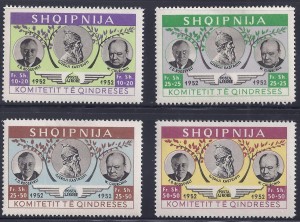 Same basic design as Series 5 in new colors and all inscribed “1952”. These were printed from the same plates as Series 4, with the color changes and the 1952 inscription added.
Same basic design as Series 5 in new colors and all inscribed “1952”. These were printed from the same plates as Series 4, with the color changes and the 1952 inscription added.
| Details, designs A13 – A16, 1952? | ||||||||||||||||||||||||||||||||||||||||||||||||||||||||||||||||||||||||||||||||
Printing Method: Photogravure, sheets of 50, some exist without gum (a)Perforation: (B) 14 x 14, (C) ImperfSize: 44.5mm x 28.5mm
|
The “E” Flaw
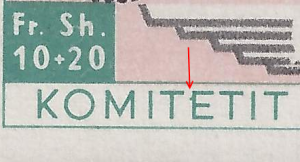 The E flaw provide provides the evidence that Series 4 and Series 5 were both printed from the same plates. The “E-Flaw” appears on the 10+20 Fr Shq stamp in each set (#11 and #15). It does not appear on any of the other stamps in the series.
The E flaw provide provides the evidence that Series 4 and Series 5 were both printed from the same plates. The “E-Flaw” appears on the 10+20 Fr Shq stamp in each set (#11 and #15). It does not appear on any of the other stamps in the series.
This could also indicate that both series were printed at the same time.
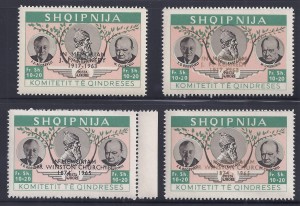 Overprints on Series 4 and Series 5
Overprints on Series 4 and Series 5
2 known overprints exists on both Series 4 and Series 5 stamps (all denominations). They are known in 2 colors: Black and Gold. The overprints are “In Memoriam” overprints for Kennedy (who died in 1963) and Churchill (who died in 1965).
The overprints are fairly common and were probably introduced to capitalized on “mourning issues” of worldwide stamps that were circulating at the time
Overprint I: (In (a) Black or (b) Gold)
- F. KENNEDY
1917 – 1963
| Details, designs A9 – A16, Overprint I (Kennedy), 1963? | ||||||||||||||||||||||||||||||||||||||||||||||||||||||||||||||||||||||||||||||||||||||||||||||||||||||||||||||||||||||||
Printing Method: PhotogravurePerforation: 14x14Size: 44.5mm x 28.5mm
|
Overprint II: (In (a) Black or (b) Gold)
SIR WINSTON CHURCHILL
1874 – 1965
| Details, designs A9 – A16, Overprint 2 (Churchill), 1965? | ||||||||||||||||||||||||||||||||||||||||||||||||||||||||||||||||||||||||||||||||||||||||||||||||||||||||||||||||||||||||
Printing Method: PhotogravurePerforation: 14x14Size: 44.5mm x 28.5mm
|
Overprint Varieties
A number of overprint “Varieties” exist. There are double overprints and inverted overprints that appear on the market. In addition, on a few occasions a set described as “Silver Overprint” has appeared, although, upon inspection, these are just lightly inked black overprints.
There is also a mention of “T” (postage due) overprints on some of these stamps (mentioned in an online forum, see footnote)
Philatelic Catalogs
None of these stamps get mention in the major catalogs (Scott, Michel, Yvert, etc.) but are listed in specialty publications. Chapier’s “Les Timbres De Fantaisie” lists these, as does “The Cinderella Philatelist”, Volume 1, January 1961.
Covers
To date, some covers bearing the stamps of sets 2 and 3 have been seen in online auctions.
These covers are probably purely philatelic and didn’t travel through the mail, and both have postmarks with the town name “Oroshi”.
Cover A – “Expres” to USA
This cover bears 2 stamps from Series 2 and 3. #8 – 50 Fr Sh Overprint, and #9, 50-20 Fr Shq Figures of Freedom.
The cover is addressed to a “H.E.F. Stolow on 60 West 46 Street, New York and is stamped with “Expres” which is the Albanian word for “Express”
Henry Stolow was a stamp dealer and printer who emigrated to New York from Germany via Brussels in the 1930’s. Stolow was widely known for producing fantasy issues including bogus Greenland overprints, the issues of Maluku Selatan and others. This cover leads to the belief that Stolow may have been involved in the printing of sets 2 and 3, and probably sets 4 and 5 as well. If Stolow wasn’t directly involved in the printing of sets 2 and 3, at least we have evidence that he possessed a copy of the “Figures of Freedom” stamp that we know was copied and reproduced in sets 4 and 5.
The postmark dates the cover to May 30th, 1946, is labeled “Oroshi” and “KOM-QINDR” which is probably an abbreviation of Komitetit Te Qindreses
Cover B – Airpost to Rome
This cover bears all 4 stamps from set 2 and the single stamp from set 3. It contains an Oroshi postmark as well as an Airpost postmark on the back with Roma Ferrovia which indicates a post office at a railway station in Rome. This cover is likely bogus as there are reports of similar faked covers from Rome.
The address is blemished but reads in part: Alle STUDIO __?___ ALBANESE ROMA. Alle is Italian for “To” Studio translates to “Study” and Albanese is “Albanian” and ROMA is Rome.
The postmark on the front is dated May 16th of 1947, “Oroshi”, “Posta Ajrore” and the postmark on the back shows May 14th, 1947, Posta Aerea, Roma Ferrovia.
Oroshi Postmark
The significance of the Oroshi postmark is historical and relates to the 1911 event when Albanian Independence was proclaimed and the first provisional government was established led by Terenzio Tocci.
The Oroshi postmark was also used nearly 30 years earlier on a set of bogus cinderella stamps for the Republic of Mirdita (Mirdites). Its significance is further evidence of the philatelic nature of these resistance covers as Albania was under communist control and no cover could have left Oroshi (Orosh) with these stamps on them.
Promotion and Sale
The set 4 and 5 stamps “flooded” the philatelic market in the early 1950’s. A early classified advertisement in the December 1953 issue of Boys Life magazine promoted these along with other sets. These continued to be promoted with classified ads throughout the decade and ads were seen in other publications such as Popular Mechanics (January 1957 and July 1959)
In packet materials from Zenith Stamp company they were promoted as a “Secret Albania Liberation Set” and from Mystic: “Intended for use when Albania is Free from Communist Control”. The stamp dealers were probably aware of their bogus nature but offered them anyway.
Warnings in the Philatelic Press
The Philatelic community caught on quickly to the bogus nature of these stamps. The stamps were flooding the market in the United States and were being marketed to young collectors.
Stanley Gibbons Monthly in July of 1954 stated: “It is high time that we helped make it clear that they (the stamps from these countries) are absolute rubbish”. At the same time they warned of other bogus issues from “Free Croatia” and “South Moluccas”.
Other publications picked up these reports including the Stamp column of the Spokane Daily Chronicle in August of 1954, the Canadian Philatelist (See image to right), November 1954, and even an article in the March 1955 editon of Boys Life Magazine (even though the stamps were being advertised in the Boys Life Classified section).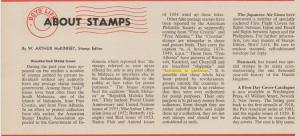
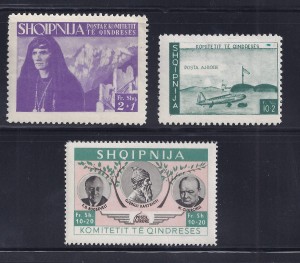

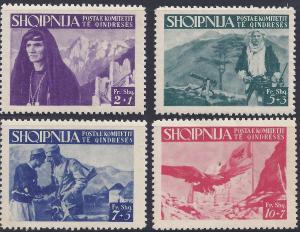
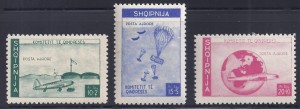
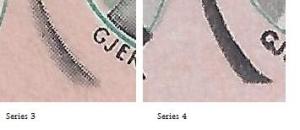
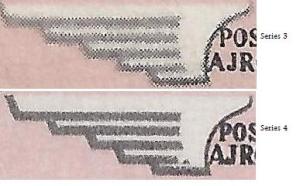
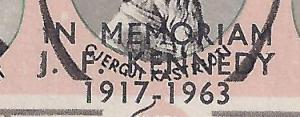

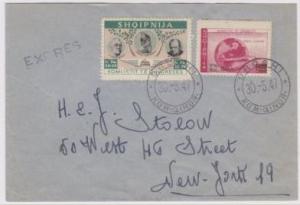
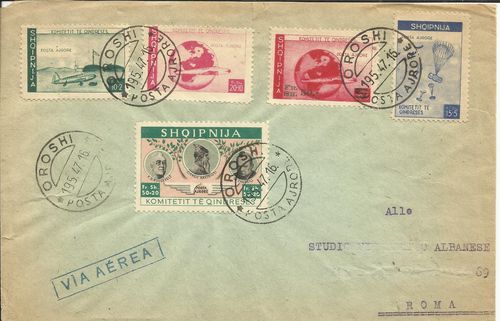
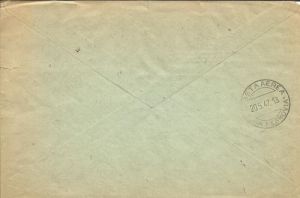

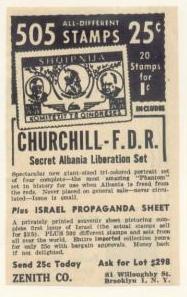
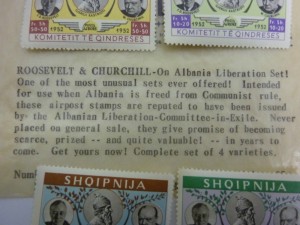
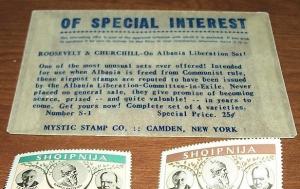
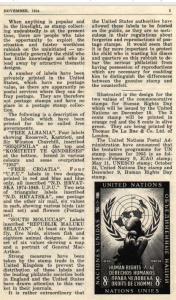
to whom it may concerne ,,,,, dear sir madam ….. i have shqipnija stamps komitetit te qindreses ,,, in very good condition ,,, i will be appriciated if you let me know ,, how much this stamps worths ,,, thanks ever so much and hope to hear very soon . yours sincerlyes ar s afshar
The set (7 stamps) is rather rare. The worth, according to German Michel- catalogue is valued at (about) 70.- €. Sellers in internet (e.g. ebay) offer the set with prices from 32.- to 59.- €.
Experts are convinced that the Michel-price of 70.-€ is below value.
By all means: Keep the stamps !
The term SHQIPNIJA originates from the Gheg- dialect, spoken in the north of Albania, in Kosovo, Montenegro, Serbia and parts of Macedonia. It means “Albania”. The set was edited by the Albanian Resistance Committee (against Italy!) under the German occupation.
The term was only used for these seven stamps.
After 1950 you can find the spelling SHQJPERIA in literature, too.
With kind regards
Hans-Gerd Dahmen
26655 WESTERSTEDE- Ocholt
Germany
When will the moderation be finished?
With kind regards
Hans-Gerd Dahmen
Thank you for the info!
You can see all of the items in my collection here. I have a quite a few interesting and random items
http://www.eworldstamps.com/category/albania-exile-government/
I am just trying to value my stamps, I have had the stamp below for a number of years and this is the first time I have found anything on it. Could you please give an estimate of the value please – I tried to attach a copy of the stamp, I was unsuccessful.
I have series 5 new colour “1952” – only one stamp with is green 25 + 25, mint, Komitetit te Qindreses.
Thank-you for your help.
Thanks for the ID!
I wondered why I could not find these in Scott.